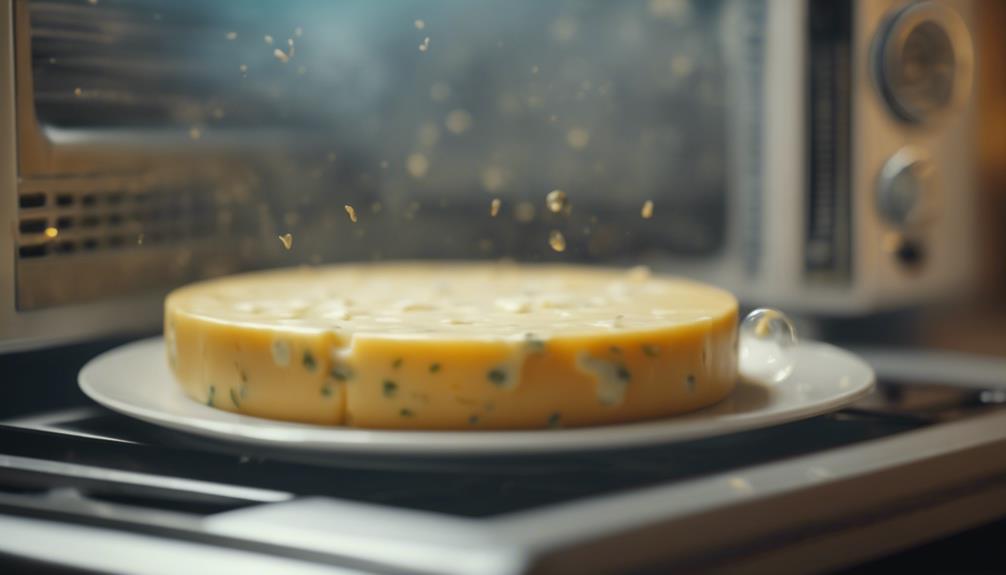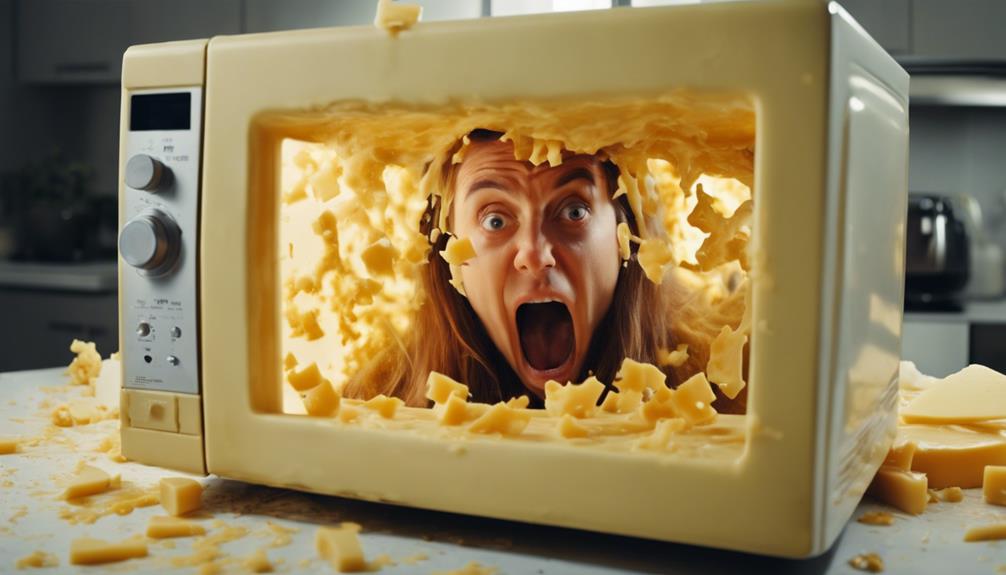Can You Microwave Cheese
Yes, you can microwave cheese to achieve a melted and gooey texture. The microwave can be a convenient tool for quickly melting cheese, especially when you're in a hurry or don't want to dirty additional dishes.
However, it's important to keep in mind that microwaving cheese requires careful timing and attention to prevent it from becoming overcooked or developing a rubbery texture. It's best to microwave cheese in short bursts, checking and stirring it frequently to ensure even melting.
Additionally, choosing the right type of cheese can also affect the outcome, as some varieties melt better than others. So, while microwaving cheese can be a viable option, it's important to approach it with caution and experiment with different techniques to achieve the desired oozy goodness.
Key Takeaways
- Choose high-moisture cheeses for optimal melting results.
- Microwave cheese in short intervals at low heat settings.
- Stir cheese between heating sessions for even melting.
- Use microwave-safe dishes to prevent damage and ensure safe, consistent melting.
Melting Cheese in Microwave
Melting cheese in the microwave is a convenient method for quickly achieving a smooth and uniform consistency, especially when working with small quantities. To melt cheese effectively in the microwave, it is essential to use a microwave-safe bowl and heat the cheese in short intervals.
Room temperature cheddar or any cheese will melt more evenly and consistently compared to cold cheese. It is crucial to avoid using high heat settings as this can cause the cheese to become greasy or clumpy.
Additionally, stirring the cheese between heating intervals is recommended to ensure a smooth and uniform melting process. By following these guidelines, you can efficiently melt cheese in the microwave without compromising its texture or flavor.
Choosing the Right Cheese
When selecting cheese for microwaving, opt for varieties like cheddar, Swiss, or Gruyère with higher moisture content to achieve optimal melting results. Cheeses with higher moisture content melt more easily, resulting in a smoother texture when melted.
It is advisable to use room temperature grated cheese for even melting in the microwave. Avoid low-fat or low-moisture cheeses like Parmesan, as they may not melt well.
To prevent overheating and ensure a perfect melt, microwave the cheese in short intervals of 15-30 seconds. Experimenting with different cheese varieties can help you determine the best option for your specific microwave cheese dish.
Choose wisely to enjoy delicious melted cheese without compromising on texture.
Tips for Perfectly Melted Cheese

When it comes to achieving perfectly melted cheese in the microwave, understanding cheese melting methods, selecting the right cheese, and avoiding cheese clumping are key points to consider.
By following these tips, you can ensure that your cheese melts evenly and smoothly without any greasiness or rubbery texture.
Patience and attention to detail will help you master the art of microwaving cheese to perfection.
Cheese Melting Methods
For achieving optimal results when melting cheese, it is advisable to utilize shredded cheese as it melts more uniformly and smoothly in various dishes and sauces. When melting cheese, using low heat settings is crucial to prevent it from becoming greasy or clumpy. Cheese at room temperature requires less heating time in the microwave, ensuring a more even melt. Patience and consistent stirring are key elements to achieving perfectly melted cheese. Cheeses with higher moisture content such as cheddar, Swiss, and Gruyère are best suited for melting due to their texture and consistency. Below is a table summarizing the key points for successfully melting cheese:
| Key Tips for Melting Cheese |
|---|
| Use shredded cheese |
| Melt cheese on low heat |
| Stir cheese continuously |
| Opt for cheeses with higher moisture content like cheddar, Swiss, and Gruyère |
Cheese Selection Tips
To enhance the melting process of cheese and achieve optimal results, selecting cheeses with higher moisture content such as cheddar, Swiss, or Gruyère is essential. Cheeses with more moisture content than Extra, when shredded and brought to room temperature, melt more smoothly.
The texture of the cheese also plays a significant role in how well it melts, making softer cheeses like brie ideal for a cheese sandwich. Additionally, cheeses with high-fat content tend to melt better than their lower-fat counterparts.
When using the microwave to melt cheese, consider these tips for a perfectly melted result that enhances the flavor and texture of your dish.
Avoiding Cheese Clumping
In ensuring a smooth and perfectly melted cheese consistency, it is advisable to shred mild or sharp cheddar cheese to prevent clumping and achieve a desirable texture.
When melting cheese, follow these essential tips for optimal results:
- Use low heat to gradually melt the cheese without risking clumping.
- Stir frequently to evenly distribute the heat and maintain a smooth texture.
- Avoid overheating the cheese, as it can cause clumping and result in a rubbery texture.
Freshly grated cheddar offers a creamier texture and reduces the likelihood of clumping. Exercise patience, stick to low heat, and employ regular stirring to achieve perfectly melted cheese without any unwanted clumps.
Avoiding Common Mistakes

When microwaving cheese, it is essential to employ proper techniques to prevent undesirable texture changes. To avoid a rubbery texture or greasiness, melt cheddar cheese using a low heat setting in short intervals. It is recommended to use room temperature cheese for easier and more even melting. Additionally, prevent overheating the cheese to maintain its texture and avoid clumping. Utilize microwave-safe containers to prevent any adverse reactions with the cheese during the heating process. Remember to stir the cheese between heating intervals to ensure even melting and to eliminate any potential hot spots.
| Common Mistakes to Avoid | Tips for Success |
|---|---|
| High heat settings | Use low heat for even melting |
| Overheating cheese | Heat in short intervals |
| Cold cheese | Allow cheese to reach room temperature for better results |
Quick Cheese Melting Techniques
When it comes to melting cheese quickly, safety is paramount. Understanding which cheeses melt best in the microwave and following essential tips can lead to successful results.
Cheese Melting Safety
For optimal safety when melting cheese in the microwave, always ensure to use a microwave-safe bowl or container.
Quick Tips for Cheese Melting Safety:
- Microwave cheese in short intervals of 15-30 seconds to prevent overheating and ensure even melting.
- Stir the cheese between each interval to promote even melting and avoid hot spots.
- Be cautious when handling the hot bowl or container after microwaving cheese to prevent burns. Use oven mitts or a kitchen towel to handle the hot container safely when removing it from the microwave.
Best Melting Cheeses
Cheddar, Swiss, and Gruyère are renowned choices for melting cheeses, favored for their higher moisture content and lower melting points.
When melting cheddar, whether mild or sharp, it is advisable to use room temperature cheese for a smoother and quicker melt. To prevent overheating and ensure optimal melting, it is recommended to use low heat settings in short intervals.
Additionally, freshly grated cheese is preferred over pre-shredded cheese, as it lacks additives that may affect the melting process. By choosing cheeses with high moisture content and shredding them before microwaving, you can achieve a more even and efficient melt.
Microwave Melting Tips
Effectively melting cheese in the microwave requires employing low heat settings to prevent overheating and maintain the desired texture of the cheese. To ensure successful cheese melting, here are some quick tips:
- Use Low Heat: Opt for low microwave heat settings to prevent the cheese from overheating and losing its texture.
- Melt in Short Intervals: Heat the cheese in short intervals of 15-30 seconds to control the melting process and avoid overheating.
- Stirring: Stir the cheese in between heating intervals to promote even melting and prevent clumping.
Microwaving Cheese Safely
When microwaving cheese safely, it is imperative to use microwave-safe dishes and containers to prevent any damage or melting issues. Cheese should be cut into small, even pieces for more uniform melting. It is advisable to microwave cheese in short intervals at low heat settings to ensure gradual melting without overheating. Covering the cheese with a microwave-safe lid or plastic wrap can help trap steam and aid in the melting process. Be cautious and monitor closely while microwaving cheese, as it can quickly transition from melted to burnt. Here is a table summarizing key points for safely microwaving cheese:
| Key Points | Details |
|---|---|
| Use Microwave-Safe Dishes | Prevents damage and melting issues |
| Cut Cheese Into Small Pieces | Ensures uniform and efficient melting |
| Microwave at Low Heat Settings | Avoids overheating and ensures gradual melting |
Frequently Asked Questions
Can You Microwave Cheese Straight From the Fridge, or Should You Let It Come to Room Temperature First?
For optimal results when microwaving cheese, it is advisable to allow it to reach room temperature before heating. This approach facilitates quick melting, maintains cheese texture, and helps avoid potential issues such as uneven melting or a greasy consistency.
Are There Any Types of Cheese That Should Not Be Microwaved Under Any Circumstances?
Certain cheeses, like hard aged ones, soft creamy varieties, blue cheeses, and fresh options, should be avoided for microwaving. Melting can affect texture, flavor, and consistency, impacting cheese dishes, recipes, toppings, and fondue.
Is It Safe to Microwave Cheese in Plastic Containers or Should You Transfer It to a Microwave-Safe Dish?
When microwaving cheese, prioritize safety by choosing microwave-safe containers to prevent harmful chemical leaching. Transfer cheese to appropriate dishes if unsure. Follow guidelines for optimal melting. Store leftovers properly in the refrigerator for extended freshness.
Can You Use a Microwave Cover or Lid When Melting Cheese, or Should It Be Left Uncovered?
When melting cheese in the microwave, consider using a microwave cover or lid to regulate heat distribution, control texture, and prevent splattering. Experiment with heating options to achieve desired cheese consistency, flavor preservation, and melting time based on the dish prepared.
How Long Can You Store Leftover Melted Cheese in the Refrigerator Before It Should Be Thrown Out?
Leftover melted cheese can be stored in the refrigerator for 3-4 days before being discarded. Proper storage in an airtight container is crucial. When in doubt about freshness, it's best to discard. Avoid multiple reheats to ensure food safety.
Conclusion
In conclusion, the microwave can be a convenient tool for melting cheese, but it is essential to exercise caution and follow proper techniques to achieve the desired result.
By choosing the right cheese, melting it in short intervals at low heat, and avoiding common mistakes, you can enjoy perfectly melted cheese in a quick and efficient manner.
Remember to prioritize safety and precision when microwaving cheese for optimal results.
